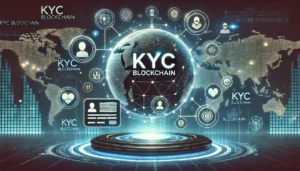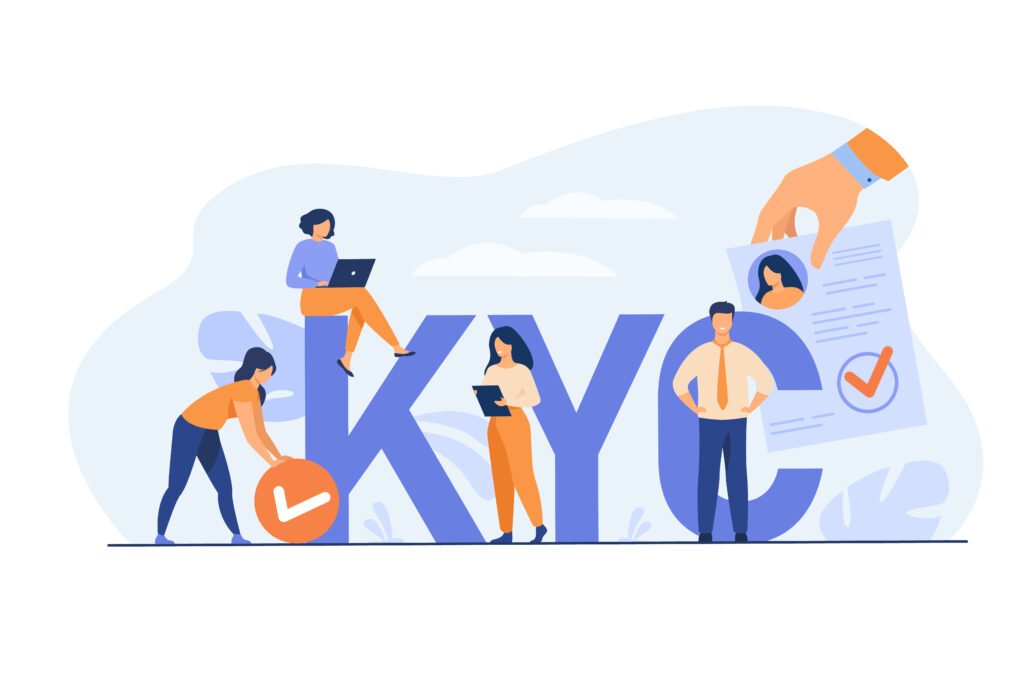KYC and AML practices are vital to ensure compliance and security in the blockchain ecosystem.
KYC/AML Practices in Blockchain

Introduction
As cryptocurrency and blockchain grow in popularity, regulators and financial institutions scrutinize the potential for illicit activities—from money laundering to tax evasion. To mitigate these risks, authorities worldwide require KYC (Know Your Customer) and AML (Anti-Money Laundering) protocols. Yet these safeguards can clash with the decentralized ethos of peer-to-peer blockchain networks, where transactions happen without central oversight.
In this article, we’ll clarify KYC/AML basics, how they’re enforced in centralized exchanges and the DeFi space, and how users can comply with identity checks. We’ll also address privacy concerns, examine global regulations, and assess the future of identity verification in an ever-evolving crypto landscape. By understanding KYC/AML practices, you’ll see why governments push for accountability and how the crypto community balances security, innovation, and privacy.
Why KYC/AML Matters in Crypto
Preventing Money Laundering
- Criminals may use pseudonymous crypto addresses to hide illicit proceeds or finance illegal activities.
- Tracking flows through identity checks discourages criminals from abusing platforms.
Regulatory Compliance
- Exchanges and other service providers face fines or shutdown if they fail to meet global AML standards.
- Building trust with mainstream investors requires proving robust security and transparency.
Consumer Protection
- Verifying users can thwart phishing or account takeovers, ensuring stolen funds or personal data are less accessible to fraudsters.
Market Maturity
- Clear compliance frameworks encourage institutional entry, fueling liquidity and acceptance.
Overview of KYC and AML
KYC: Know Your Customer
- Identity Verification: Customers provide personal information (name, address, ID documents).
- Purpose: Confirm the individual is who they claim to be, ensuring no involvement in sanctions or blacklists.
AML: Anti-Money Laundering
- Transaction Monitoring: Systems flag suspicious or high-value transactions for review.
- Reporting: Suspicious Activity Reports (SARs) sent to authorities if patterns suggest laundering or terrorism financing.
- Compliance: Institutions adopt risk-based approaches, intensifying checks on high-risk users or regions.
Tools and Processes
- ID Document Scanning: Passports, driver’s licenses, or national IDs.
- Face Verification: Selfies or biometric scans matched with ID photos.
- Address Validation: Utility bills, bank statements, digital identity solutions.
- Sanctions and PEP Lists: Checking if a user appears on watch lists or is politically exposed, requiring extra diligence.
How KYC/AML Applies to Blockchain
Blockchain transactions are inherently pseudonymous. Anyone can generate new addresses without real-world identity checks. Governments worry such anonymity could be exploited for laundering money or evading taxes. Hence, they impose KYC/AML at on/off ramps—centralized exchanges or payment providers that convert fiat to crypto or vice versa. This ensures:
- Tracking who’s depositing or withdrawing large sums.
- Identifying potential suspect addresses and blacklisting them.
- Freezing stolen funds if a hack is reported promptly, though success is not guaranteed since blockchain transactions are final.
DeFi complicates matters further because protocols often operate autonomously via smart contracts, lacking a direct “owner” to enforce KYC. Regulators thus focus on user interfaces, stablecoin issuers, or aggregator sites to impose compliance measures.
KYC/AML in Centralized Exchanges
Registration
- Users create accounts, providing personal info (email, phone, etc.).
- Higher deposit or withdrawal limits often require deeper verification—uploading ID scans, proof of address, or selfies.
Tiered Account Levels
- Non-KYC or basic accounts might have limited transaction sizes. Full KYC typically unlocks unlimited usage.
- Examples: Binance, Coinbase, Kraken—each with varying thresholds.
Ongoing Monitoring
- Exchanges track trading patterns. Large or suspicious transactions trigger manual reviews.
- Some platforms freeze accounts if anomalous activity is detected.
Enhanced Due Diligence (EDD)
- For high-risk users or politically exposed persons (PEPs). Additional background checks or requests for source of funds.
Sanctioned Countries
- Many centralized exchanges block IP addresses or refuse service to users from countries under global sanctions (e.g., North Korea, Iran). This geofencing enforces compliance but can conflict with crypto’s open ethos.
DeFi and the Challenges of KYC Compliance
DeFi’s Permissionless Nature
- Smart Contracts run automatically, no central operator to enforce identity checks.
- Censorship Resistance: The code is unstoppable as long as nodes uphold the chain’s consensus.
Potential Approaches
- Front-End Blocking
- Some DeFi dApps block certain regions or addresses at the UI level. However, advanced users can still call contracts directly or use alternative front-ends.
- Layer-2 or Proxy
- Solutions that embed KYC gating at bridging steps or stablecoin issuance, ensuring compliance around user flows.
- Regulated DeFi
- Protocols might create “permissioned pools” for verified institutional clients. This merges blockchains with real-world compliance checks.
Criticisms
- DeFi purists argue mandatory KYC breaks the decentralized ideal.
- Regulators fear criminals exploit fully open protocols.
- The debate continues, with no universal standard yet.
Practical KYC Steps for Crypto Users
Choose a Compliant Exchange
- Reputable platforms with a track record of abiding by local laws. This generally ensures better user protection, though less privacy.
Prepare Documents
- Government-issued ID, proof of address. Some exchanges also require a live selfie or video call.
Check Regional Restrictions
- Certain states or countries have separate guidelines. Exchanges might not operate in your region or could require extra details.
Maintain Transaction Records
- For taxes or potential compliance checks, keep logs of trades, wallets used, fiat amounts.
Stay Updated
- Laws can change quickly. If a platform modifies KYC rules, failing to comply might freeze your account or withdraw abilities.
AML Tools and Blockchain Forensics
Transaction Analysis Platforms
- Companies like Chainalysis, Elliptic, CipherTrace track flows across addresses, identifying suspicious patterns or known illicit wallets.
Sanctioned Addresses
- OFAC (U.S.) publishes blacklists of addresses tied to terrorists or hackers. Exchanges must block interactions with them.
- Some contracts or stablecoin issuers (like Circle for USDC) can freeze blacklisted funds.
Risk Scoring
- Tools assign risk scores to addresses based on past activity (large mixers, known scams). If an address is high-risk, some dApps or exchanges might refuse transactions.
Privacy Solutions
- Privacy coins or mixers hamper forensics, leading to tension with AML compliance. Some governments ban or heavily regulate these solutions.
Privacy Concerns and Balancing Factors
KYC and AML gather sensitive personal data, meaning:
- Data Breaches: If an exchange is hacked, personal info could leak.
- Surveillance: Government or chain analysis can de-anonymize user addresses.
- Oversight: Some argue robust KYC defeats the purpose of trustless, self-sovereign finance.
Balance: Tools like zero-knowledge proofs might let users prove they’re not on sanctions lists without revealing full ID. This “selective disclosure” could preserve privacy while still meeting legal demands.
Global Regulatory Landscape
United States
- Crypto businesses register as Money Services Businesses (MSBs) with FinCEN, applying KYC.
- State-level rules vary—e.g., BitLicense in NY imposes higher compliance costs.
Europe
- The EU’s MiCA (Markets in Crypto-Assets) will unify requirements, including AML directives for crypto service providers.
- Exchanges must meet AMLD guidelines, verifying users at certain thresholds.
Asia-Pacific
- Japan requires FSA licensing for exchanges with strict KYC rules. Singapore’s MAS Payment Services Act imposes AML steps for crypto firms.
- China bans most crypto trading, focusing on state-run digital yuan.
Middle East and Africa
- UAE’s VARA in Dubai, ADGM’s frameworks attract crypto companies with moderate KYC.
- Nigeria’s high adoption leads to friction with central bank warnings; local exchanges adopt partial KYC.
Latin America
- El Salvador recognized Bitcoin as legal tender but offers minimal direct KYC for on-chain usage. Other countries adopt or refine laws. Enforcement often remains inconsistent.
Future Outlook for KYC/AML in Blockchain
Enhanced Identity Solutions
- Decentralized Identifiers (DIDs) and verifiable credentials could let users share only minimal proof of identity, bridging AML needs with privacy.
Protocol-Level Enforcement
- Some blockchains might incorporate compliance layers or optional “whitelisted” subnets. DeFi dApps may create regulated pools for verified users.
Growing Institutional Involvement
- Banks, hedge funds demand clearer AML compliance to commit large sums, prompting advanced compliance solutions integrated directly into user workflows.
Harmonized Regulations
- FATF guidelines push standardization, including the “Travel Rule.” Over time, more countries may adopt similar frameworks, reducing confusion for global platforms.
Privacy-Preserving KYC
- Tools using zero-knowledge proofs to confirm a user is not on blacklists without revealing their entire identity, balancing compliance and anonymity.

Conclusion
KYC/AML procedures in the crypto and blockchain sphere seek to align decentralized technology with regulatory standards. While the immutable, pseudonymous nature of blockchain complicates typical compliance, centralized exchanges have become the main front line for verifying users and monitoring suspicious behavior. Meanwhile, DeFi’s permissionless design raises debates about how to enforce AML without undermining decentralized ideals.
Understanding KYC/AML is essential for anyone navigating the crypto world—exchanges typically require identity checks for higher limits, and future DeFi interfaces may do the same. Tools like blockchain forensics help track illicit funds, though these methods also raise privacy concerns for legitimate users. The path forward might include innovative identity solutions that confirm compliance while preserving user autonomy. As regulatory clarity expands, expect more standardization of KYC across fiat on/off-ramps, stablecoins, and possibly some DeFi corners—aiming to keep criminals out while letting honest users benefit from the borderless promise of blockchain.
Additional Resources
FinCEN
fincen.gov – U.S. regulator responsible for AML frameworks. Learn about MSB registrations and SAR reporting guidelines.FATF
fatf-gafi.org – Global anti-money laundering body providing recommendations (Travel Rule) for crypto service providers.Chainalysis
chainalysis.com – Leading blockchain forensics company, offering AML compliance solutions and suspicious transaction monitoring.Elliptic
elliptic.co – Another top-tier provider of crypto compliance and analytics software for exchanges and governments.Binance Academy
academy.binance.com – Articles on AML/KYC, how centralized exchanges implement identity checks, and tips to pass verifications smoothly.EU’s MiCA
ec.europa.eu/info – Official site for the European Commission. Search “MiCA” for the proposed regulatory framework covering crypto-assets and related AML rules.
